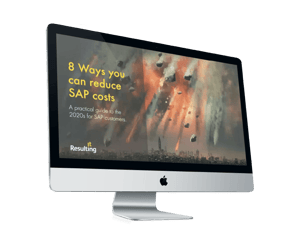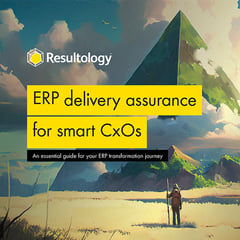8 ways you can reduce SAP costs (including a straight forward plan to reduce SAP licensing costs)
TABLE OF CONTENTS
A practical guide to eliminating waste for SAP customers
SAP has never been cheap to implement. The capital costs are often amortised over five to ten years and on top of this you have the ongoing operational costs of running, supporting and maintaining the system. In the current climate, with the dramatic reduction in demand across many businesses, controlling and reducing these costs is essential to their survival and future success.
Running counter to this, SAP skills are becoming also scarcer and more expensive. SAP isn’t the cool kid any longer with new entrants to the IT industry preferring to get involved in the shiny world of web or ‘app’ development. The decrease in the supply of skills has also coincided with an increase in demand due to the impact of Brexit and the burning S/4 upgrade platform.
It is also notoriously difficult to demonstrate the benefits and return on investment from a SAP programme making the business case for spending additional money an issue and the need to control existing spend and save money critical.
So how can you start to identify potential savings on your SAP running costs?
Gartner undertook a benchmarking exercise a few years ago with wide range of SAP customers and they identified the three big areas that contribute to the ongoing running costs of your SAP estate:
- 66% - Staff and Skills
- 24% - Licensing
- 10% - Hosting
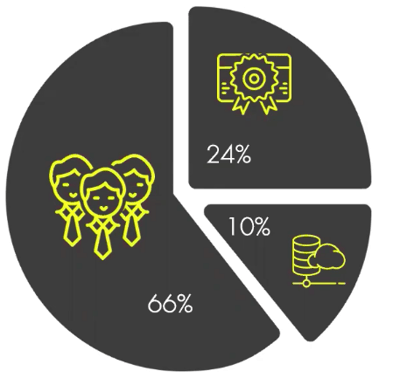
Using Muda to reduce SAP TCO
A number of the Resulting team come from a Manufacturing background and quite often on consulting engagements we bring in metaphors or techniques from manufacturing.
Japanese manufacturers have focussed on the reduction of a concept called ‘muda’ for many years. There isn’t an exact translation of ‘muda’. It means wastefulness, uselessness and futility – the opposite of value-addition, where value-added work is a process that adds value to the product or service that the customer is willing to pay for.
The Toyota Production System identifies eight types of ‘muda’ that are the root of all unprofitable activity that need to be eliminated:
- Defects – effort caused by rework, scrap and incorrect information
- Overproduction – making more than a customer requires
- Waiting – wasted time waiting for the next step in a process
- Extra Processing – higher quality than required by the customer
- Transportation – unnecessary movement of products and materials
- Inventory – excess products and materials not being processed
- Motion – unnecessary movement by people
- Non-utilised talent – under-utilising people’s talent, knowledge and skill
![]()
By plotting these against the main SAP costs, we can start to see where our SAP ‘muda’ might be hiding and start to drill down and identify ways to save money.
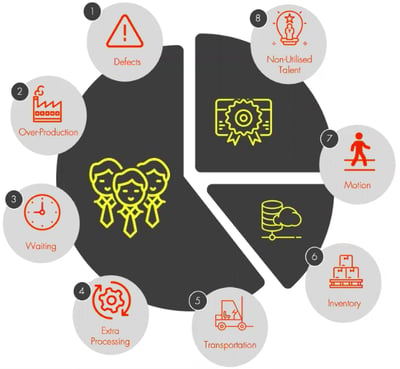
Learn how to avoid defects in SAP and SAP S/4HANA
Defects cost whichever way you look at it. They cost to build, to test and to retest and they cost even more if they hit Production and impact business processes.
There is also the cost of ‘hidden factories’ which is another manufacturing metaphor that exists where you inspect for defects at the end of a manufacturing or development process. This can hide if defects go through the inspection process multiple times before they are resolved.
Consider whether you are paying your Systems Integrator to resolve defects that they have created.
Day Rates x Defects = Waste
Are you performing effective Defect Management? Should you be focussing on Defect Reduction instead? This is where you put measures in place to prevent defects occurring in the first place.
If your Systems Integrator or Outsourcing Partners is managing defects, consider what carrots and sticks you can use to reduce defects. You can challenge them to not charge for defects that they created. You can also look at the stage where you identify defects. The earlier you can identify a defect, the less it will end up costing.
The SAP over-production problem -How often should you make changes?
The single fastest way to save money with SAP is to stop doing things. Two thirds of your SAP running costs relate to staff and skills and these costs are driven higher by the impact of every single change request – from specification to deployment, through to the ongoing ‘technical debt’ cost and ultimately an ‘unravelling’ or decommissioning cost.
Have you considered the impact of all those Z programs and other customisations on your S/4 journey?
Recent analysis has shown that up to 50% of custom transactions are unused which means that identifying them as part of your S/4 migration is a huge opportunity to reduce complexity and cost.
Have you considered who signs off purchase orders in your SAP team?
Most people will say that it is either Procurement or a senior stakeholder in the IT organisation with budget authority.
In reality, the person who can commit the most spend is often the person who hands out or approves transports into your SAP Production system. These are the people who are often giving developers the green light to start development work and burn cost. There is also a huge area of hidden waste around ‘orphaned’ transports where development is initiated but never completed.
You can eliminate waste by implementing a better way of selecting what you do and then governing what you do properly from initiation through to deployment. Now is the time to batten down the hatches and do only what is necessary. It will save you money and it will also make your S/4 journey a smoother one.
How to reduce wait time and downtime in your SAP programme
Have you felt the frustration of having your entire programme team waiting around for a test phase to complete before other work can continue? Or has your business suffered because the programme has had to take key business resources away from their day job in order to support testing?
If the answer to either of these questions is yes, you should be evaluating test automation.
Test Automation used to be Science-fiction. The technology has moved on and it is now quick and simple to implement – but there are traps.
A Systems Integrator may look to implement 'test automation' that requires an army of people to maintain scripts. The testing will sound inexpensive, it may even be open source, but it could come with a hidden maintenance cost.
Good test automation tools, those in the top-right of the Gartner Magic Quadrant , have intelligent maintenance built in and require minimal maintenance or fast re-recording. For example, a good tool should only take 20% more time to record than running the test in the first place. Combined with this, they will use techniques such using object ID’s on the screen that the script will recognise even if the screen layout is altered.
The ROI on test automation will usually be based upon the reduction of waiting time for the rest of your SAP team. Consider what your run-rate is for the team waiting around for UAT and Regression Testing to complete. The true ROI on test automation though is the ability to ship functionality that impacts your top and bottom line on time or even earlier than planned.
Now is the perfect time to properly evaluate the impact that test automation can have on the duration of your programmes and wait time within your business. Aligned to this is the consideration of risk-based testing. There are various tools available that will tell you what you should be testing based upon analysis of what you are changing and who is using them.
How to eliminate the hidden processing costs of your SAP solution
Your Systems Integrator or Outsourcer is an over-processing machine. They are not charities - they are commercial organisations, driven by growth - and you are a source of purchase orders.
They will take an opportunity where it exists and when they propose a solution, you need to consider whether it is the simplest or cheapest option. Who is the solution benefitting?
Similarly, if you are using Contractors, does human psychology suggest that they are more likely to provide a quick fix that takes a day or something that nudges their extension over the line.
Also be wary of contractors that propose technical solutions that may be their way to get a ‘badge’ on their resume. If there is a way to increase their net worth in the market, some contractors may steer solutions to meet their own ends.
The best way to counter both of these things is to make sure that you have the right skills and capabilities in house to be able to challenge experts . Many companies have gone too far in outsourcing capabilities and become too dependent upon their suppliers. This has left them without the skills in house to properly manage the solution.
There are two areas that you should invest in to impact cost reduction it should be Vendor Management and Architecture.
A strong in-house Architecture capability will enable a customer to challenge and push back on experts, come up with simpler ways to do things and help the business to make informed decisions. This may not always mean you have to employ a full-time Architect. What is key is that you have access to people with these skills, who are working on your side and can help you face off to your Systems Integrator and ask the difficult questions.
If you are going to outsource, investing in effective Vendor Management is crucial. When you sign a contract with a Systems Integrator, you need to hold them to account on their service commitments and deliverables and you need to watch out for common traps and tricks such as increasing the rate of resources due to promotions that you have no say in.
Resulting are the UK’s only business-side SAP consulting firm which means that we’re best placed to help you get the most out of your relationship with your SAP technology partners. The Resulting CoE Toolkit details the key capabilities that a mature SAP COE requires and goes into more detail on these areas.
Your SAP cloud hosting isn’t saving you as much as you thought. Here’s why.
Most companies have started to look at hosting and may have started to migrate from an on-premise data centre and into a managed service. If you have already moved to the cloud, you will have already added some variability to your compute power and moved some of your fixed costs to variable costs.
But many companies who use hyperscalers are finding that the cost of a badly managed cloud is higher than the cost of dedicated data centres.
It shouldn’t be – and the answer comes in paying attention to the detail and monitoring your usage forensically for all environments, not just Production. You are paying for a utility service. Ensure the service includes detailed usage and ongoing optimisation metrics.
Breaking news for the cost savvy SAP users on AWS amongst us, SAP have certified the C5a family of EC2 virtual machines based on AMD EPYC processors. Put simply, they represent the best SAP Bang/$ ratio of any EC2 instance and are accessible at the speed of a simple reboot
You should also be looking to have periodic reviews with your infrastructure provider to ensure that what you purchased originally is still the best option for your company today. This may be complicated if you have separate parties managing the infrastructure and the layers on top such as monitoring but there should be someone who is able to provide a detailed plan for cost optimisation and explain the impact of varying compute power, or turning training environments off when they are not needed.
How to put wasteful data on ice to reduce the cost of your SAP solution
Data itself is also inventory and can be a source of waste.
If you have not already done it, you should run a SAP Data Volume Management exercise. If you have SAP Solution Manager or Enterprise support, this is included, and it will tell you where you have wasteful data.
The obvious next step will be to look at archiving, but this can be complex, costly and it is also a distraction. It requires planning, thinking, functional expertise, and business involvement. It is not a trivial exercise and not something that the business sees any benefit from.
Also, if you don’t have a clear S/4 Roadmap, you may find that you are archiving things now that you are going to get rid of anyway.
Recently we have been working with a number of customers to review their legacy apps and what they are paying to license, run and support these systems just to access data.
Did you know that there are cost-effective solutions available that allow you to cold-store this data? This allows you to get rid of the license requirement and put a web-based user interface on the front end that will allow you to access the transactional data for any reason such as a warranty claim or a freedom of information request.
Data Glacier models are a viable alternative to archiving and a potential ‘Bluefield’ alternative for a future S/4 move.
Take a data inventory and consider where you can offload cold data now and on your future SAP journey. Transactional Archiving isn’t the only solution.
If you want help to reduce the cost of managing your legacy data and applications, come and talk to us about reducing SAP costs.
A straight forward plan to reduce SAP licensing costs
Most SAP customers are also over-licenced.
When a company goes into an ERP programme, they usually go into it believing they will grow. At this point SAP will usually offer you a deal if you purchase additional licenses. Against this, we have seen periods such as the financial crisis, austerity and now Covid-19 where companies have contracted, and the number of SAP users has reduced.
This is compounded by the cost of maintenance. Typically, you will be paying 22% for this across your entire SAP license inventory. This can be parked, though SAP won’t always tell you about this.
It is perfectly legal to sell SAP licenses on. SAP won't usually tell you about that either but there are organisations that specialise in license brokering.
Before both of these, your priority should be to assess the low hanging fruit presented by the reclassification of users from Professional to Limited Professional. For every user you can demonstrate should be on a Limited Professional you can save £700 per user, per year – and that is before you consider people who have left or not logged on for six months.
There is another strand to this when you move to S/4 - the whole license model changes and Limited Professional users become Professional and there are additional licence types introduced. If you can get a detailed understanding of what your users are doing at a very granular level it will allow you to ‘fine tune’ and optimise your licensing and licensing costs going forward.
The final element concerns the Indirect Access (IA) and Digital Access Adoption Programme (DAAP) opportunity. You have only 18 months until December 2021 to decide whether to move to the DAAP and avoid SAP potentially reviewing you in respect to your IA exposure. On the face of it, it seems like a sensible thing to do but you will only know if it is right for your organisation if you carry out some detailed analysis and understand what your users are doing in your system today.
We would recommend that you look at running a license optimisation exercise based on real 2020 usage. This will have a return on investment within 12 months. You will probably find that you are over-licensed which provides an opportunity for an instant saving, and you will put yourself in a stronger position for your license renegotiation for S/4.
Be proactive. Don’t leave your license optimisation exercise until a licence audit is scheduled. Run one when it is not, put yourself in control and look at what savings you can make immediately. There are specialist tools that are inexpensive and can identify an instant cost saving or expose any risk of penalties that can be mitigated ahead of any audit.
How optimising your SAP ECC system can help to reduce cost - even if you’re moving to S/4
Start an ECC inventory so that you can declutter and clear the pathway for the process improvements your business demands
Resulting are one of the only organisations in the UK that have had some real success in helping companies with their S/4 business case. We have worked with a number of clients who were struggling and used our model to help them.
When SAP decided to extend standard support to 2027 and extended support until 2030 in February, this resulted in many companies deferring their S/4 migration. With Covid-19, any plans for S/4HANA migration were largely put on ice. The issue is that waiting another 5-10 years to improve your platform isn’t the answer.
Your business will continue to demand change in ECC – especially different business models as a result of a changing world.
Now is the time to address the inventory in your existing SAP system and start the long, steady background path to S/4 or something else.
Knowing which business processes you carry out today is going to be crucial to getting more value from your ECC system for the next 5-10 years and making the move to S/4 simpler.
Take an ECC inventory – what is used and where? How does custom code underpin your business processes?
- Understand what you have in ECC (what it does including custom code)
- Understand what is coming in S/4 (new functionality)
- Create a roadmap and start to simplify the what you have
- Look at best-of-breed solutions that address some of today’s issues today
As part of this you need to understand and reduce your technical debt, uncover and capture business workarounds where we are wasting time in the business, look for areas where you can improve the user interface or build composite applications that will not only solve an SAP transaction problem but will make someone’s life in the business easier and slicker. You should also prepare for use of API’s. The world of modern technology including S/4 is API-based not the old SAP world of big bulky overnight batch jobs and IDOC based interfaces.
What are the quickest ways to reduce SAP costs in the 2020s?
So how do you reduce costs in SAP ECC and SAP S/4HANA?
The events of 2020 have seen a cranking up of the need to reduce expenditure and conserve cash. Many companies are looking at which areas to look at to make a significant impact. Although opportunities will vary from business to business, there are two areas where an immediate return on investment can be achieved - Hosting and Licencing.
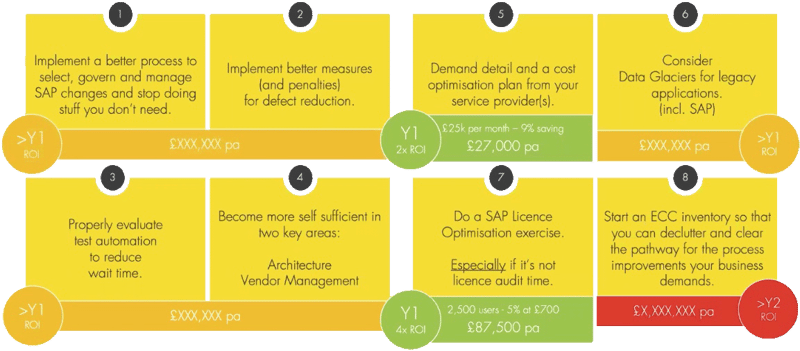
Reduce SAP Hosting Costs
Have you migrated from an on-premise data centre to a managed service? Are you realising the cost savings that the business case was built on? If not, you need to be looking into the reasons for this.
To get the best value from your service, you need to pay attention to the detail and monitor your use forensically for all environments, not just Production. You are paying for a utility service. Ensure the service includes detailed usage and ongoing optimisation metrics.
Are you having regular reviews with your infrastructure service provider? Your requirements will change over time and so will the offerings from your supplier. You need to ensure that what you purchased originally is still the best option for your business.
You should demand a detailed plan for cost optimisation and get to understand the cost impact of varying compute power, or making changes such as turning training environments off when they are not needed.
Resulting worked with a client last year who was spending £25k/month on their AWD costs. We managed to get a 9% saving through optimization of resources and turning things off when they weren’t needed. This has saved them £27k in one year - a 2x ROI.
Reduce SAP Licensing Costs
When was the last time you reviewed your inventory of SAP licenses and analysed them against your current business needs?
Most SAP customers are over-licenced. They were offered a great deal to purchase additional licenses as part of the original deal that have never been used due to the impact of various events such as the financial crisis, austerity and now Covid-19. There has been a general trend towards companies having underused licenses and the impact is compounded when you factor in ongoing maintenance costs at 22%!
What practical steps can you take to avoid paying more than you need to for SAP licenses and maintenance?
There are a variety of things you can do to address this situation. Licenses can be parked and even sold but the one thing you can do that will have the biggest immediate impact will be to run a license optimisation exercise based on real 2020 usage and take the opportunity presented by the reclassification of license tiers.
As well as identifying all the people who have left or not logged on for six months, for every user you can demonstrate should be on a Limited Professional rather than a Professional license you can save £700 per year. Understanding your license requirements in detail will also put yourself in a stronger position for your license renegotiation for S/4.
If you have 2,500 SAP licenses and just 5% are wrongly classified as Professional (a conservative estimate for a first cut!), that translates into savings of over £87k per annum, 4x ROI in one year.
Our advice is to be proactive. Don’t leave your license optimisation exercise until a licence audit is due. Get ahead of the curve, run the exercise now and put yourself in control and see what savings you can make immediately. There are tools and services available to help you identify an instant cost saving or expose any risk of penalties that can be mitigated ahead of any audit.
Make Long Term Plans to Reduce Costs
This is not to discount other opportunities.Reducing other areas of waste such as over-production, extra-processing, defects, waiting and data inventory in your SAP ecosystem and taking stock of your ECC inventory ahead of any S/4 migration are likely to yield greater savings and also allow you to make a real difference to the top and bottom line in your business.
If you would like to talk about any of these subjects and discuss how Resulting can help you to save money on your SAP running costs, please get in touch.

8 ways to reduce costs in SAP webinar
This blog is a companion piece to our on demand webinar "8 ways to reduce costs in SAP".
In the webinar Stuart Browne and Dr Derek Prior, Former SAP Research Director at Gartner, take a deep dive into the 8 points covered in this article and discuss how you can leverage them to reduce your SAP running costs.
